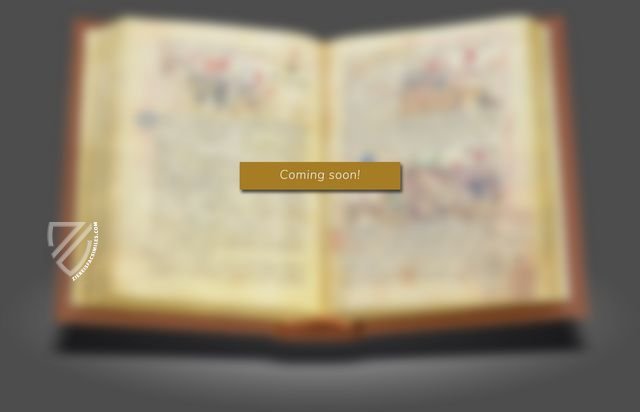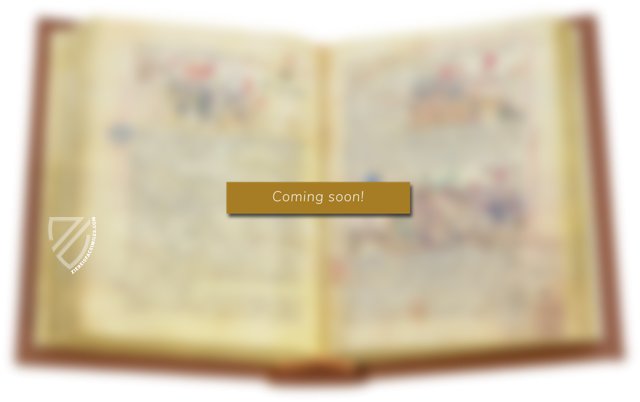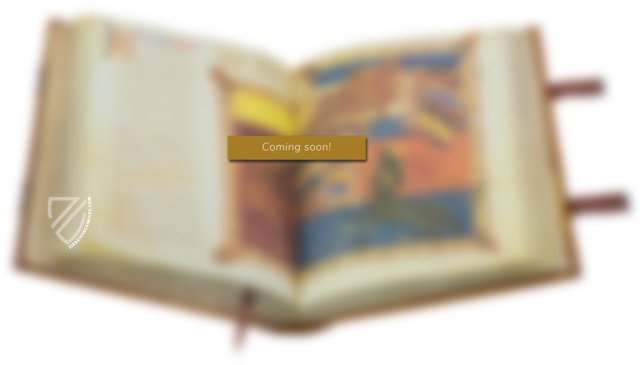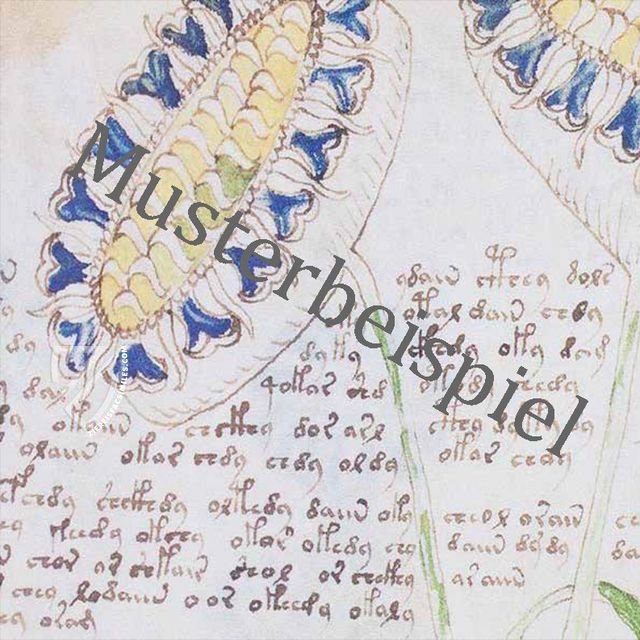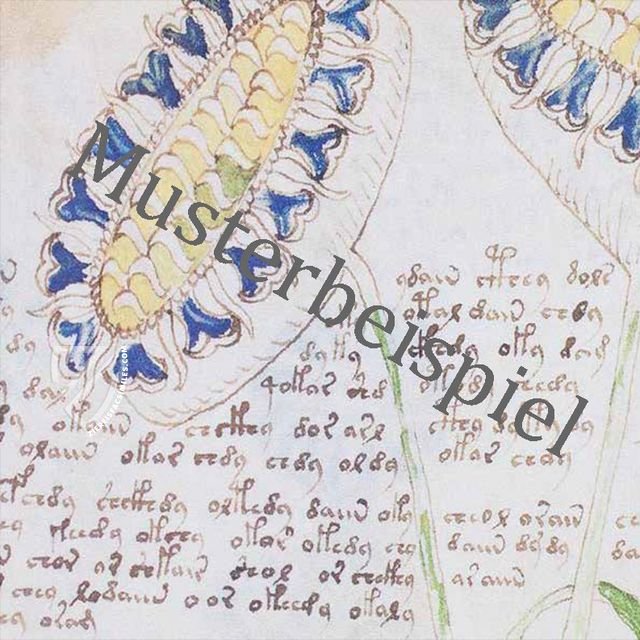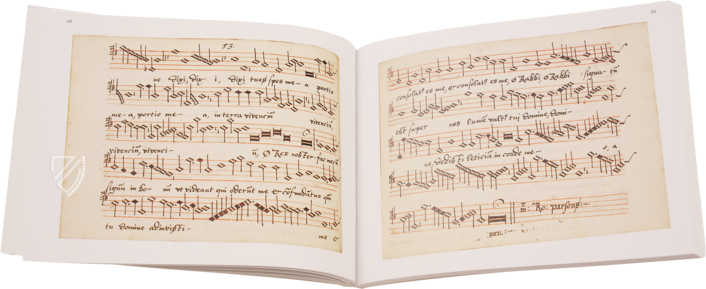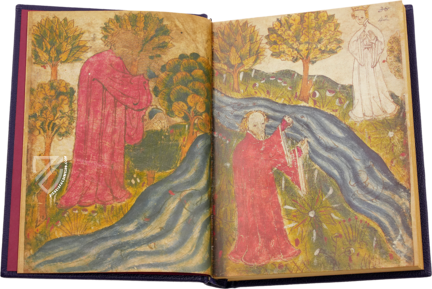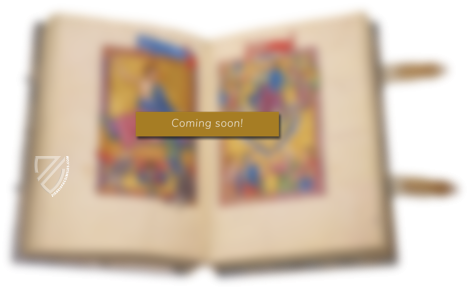Ellesmere Chaucer
(3,000€ - 7,000€)
One of the most iconic and celebrated books in the world: the so-called Ellesmere Chaucer, the most beautiful manuscript of the famous Canterbury Tales by Geoffrey Chaucer (ca. 1343–1400). Created in the decade after Chaucer’s death, it is also one of the most complete and authoritative specimens of the now-lost original manuscripts. The large-format manuscript is considered a masterpiece of late-medieval English illumination and features 200+ initials set in fantastic marginalia and rendered in rich shades of red and blue as well as gold leaf. Additionally, 23 miniatures depict the various story tellers as well as Chaucer himself, a truly special feature as portraits of medieval authors are extremely rare.
Ellesmere Chaucer
This early 15th century English manuscript it not only one of the most beautifully adorned Chaucer specimens, it is also one of the earliest, most complete, and authoritative because the original manuscripts are now lost. As such, it serves as the base text for most modern editions of the Canterbury Tales, by Geoffrey Chaucer (ca. 1343–1400), who wrote them between 1387 and 1400. Written in Middle English, the story revolves around a group of pilgrims on their way to Canterbury Cathedral to visit the tomb of Thomas Becket and participate in a storytelling contest during their travels. As such, it structurally resembles The Decameron by Giovanni Boccaccio (1313–1375), which Chaucer would have been exposed to during his Italian sojourns on behalf of the English Crown. Originating between 1400 and 1410, the Ellesmere Chaucer is named after erstwhile owner, the 1st Baron Ellesmere, Sir Thomas Egerton (1540 – 15 March 1617) who was also 1st Viscount Brackley and a member of the Privy Council of Queen Elizabeth I (1533–1607).
A Cornerstone of English Literature
It appears as though Chaucer died before he could complete the work – although 31 pilgrims are mentioned, only 24 tales are told and the return journey to London is missing. Juxtaposed between the tales are short scenes, usually taking the form of lively exchanges and even arguments between the pilgrims, who come from all walks of life: knight, prioress, monk; merchant, man of law, franklin, scholarly clerk; miller, reeve, pardoner; wife of Bath and many others. Works representing such a broad swath of society were almost unheard of. Their stories range from moralizing to downright bawdy and are open to interpretation, helping to account for their ongoing allure. The manuscript at hand is believed to be the work for the scribe Adam Pinkhurst, who had worked for Chaucer while he was alive. The revisions made in the Ellesmere manuscript suggest that they were made by someone who knew the author and his intentions, and may have had access to earlier drafts.
An Artistic Masterpiece
The Ellesmere Chaucer contains 22 of the 24 stories that make up the Tales as we know them, which are adorned with 200+ initials rendered in splendid red, blue, and gold leaf. It additionally features miniatures of the 22 pilgrims at the beginning of their respective stories, which are also adorned by wonderful marginalia of various tendrils, known as demi-vinet borders. These are distinguished by their great refinement and detail, as well as indicating that the artists responsible, perhaps as many as three, were from East Anglia. An additional miniature is a portrait of Chaucer, something truly special as depictions of medieval authors are extremely rare, even if it was made a decade after his death. The large format of the manuscript, which measures 40 x 28.4 cm, allowed both the scribe and the team of artists responsible for the illumination and miniatures plenty of room for an elegant and uncluttered design. This masterpiece is incredibly well preserved because it lay undisturbed in the library of the Barons of Ellesmere for 300 years before being professionally cared for in the Huntington Library, and was rebound in 1995 to ensure that the 240 leaves will maintain their excellent condition.
“Margery seynt John ys a shrew!”
Many illuminated manuscripts bear evidence of their ownership histories such as escutcheons from nobles who owned them or notes from librarians who catalogued them, but few have the kind of rich “graffiti” found in the fly leaves of the Ellesmere Chaucer. Most striking is the accusation written in 16th century script that someone named Margery St. John is a shrew. Poor Margery has been slandered in these fly leaves for centuries as a result, but her identity and that of the hand from which the insult came are not known. The outburst could just as easily be the result of a sibling feud as unrequited love. This and many other such entries in the flyleaves preceding and following the text include the names Robertus Drury, Thomas Calthorpp, and Edwarde Waldegrave, who coincidentally had two cousins named Margery St. John. Additionally, one finds a few lines of verse in Latin and English, other writing exercises, doodles, and pen trials. The manuscript came to the United States in 1917, a highlight in the collection of 8,000 early printed books and 13,000 manuscripts on manifold subjects dating from the Middle Ages to the 18th century sold by John Francis Granville Scroop Egerton (1872–1944), 4th Earl of Ellesmere to American railroad magnate Henry E. Huntington (1850–1927). Today it represents a highlight of the collections of the beautiful Huntington Library in San Marino, California.
Codicology
- Alternative Titles
- The Canterbury Tales. The New Ellesmere Chaucer
Ellesmere Manuscript of the Canterbury Tales
The New Ellesmere Chaucer - Size / Format
- 480 pages / 40.0 × 28.4 cm
- Origin
- United Kingdom
- Date
- Early 15th century
- Epochs
- Style
- Genre
- Language
- Script
- Anglicana
- Illustrations
- 22 figural illustrations, over 200 decorative initials with immense marginal extensions
- Content
- Canterbury Tales
- Artist / School
- East Anglian school
- Previous Owners
- John de Vere, 12th Earl of Oxford
Sir Thomas Egerton, 1st Baron Ellesmere
#1 The Canterbury Tales. The New Ellesmere Chaucer (Bound Edition)
Language: English
(3,000€ - 7,000€)
#2 The Canterbury Tales: the New Ellesmere Chaucer (Unbound Edition)
(under 1,000€)
#3 The Canterbury Tales: the New Ellesmere Chaucer (Deluxe Edition)
#4 The Canterbury Tales: the New Ellesmere Chaucer (Monochrome Edition)
- Treatises / Secular Books
- Apocalypses / Beatus
- Astronomy / Astrology
- Bestiaries
- Bibles / Gospels
- Chronicles / History / Law
- Geography / Maps
- Saints' Lives
- Islam / Oriental
- Judaism / Hebrew
- Single Leaf Collections
- Leonardo da Vinci
- Literature / Poetry
- Liturgical Manuscripts
- Medicine / Botany / Alchemy
- Music
- Mythology / Prophecies
- Psalters
- Other Religious Books
- Games / Hunting
- Private Devotion Books
- Other Genres
- Afghanistan
- Armenia
- Austria
- Belgium
- Belize
- Bosnia and Herzegovina
- China
- Colombia
- Costa Rica
- Croatia
- Cyprus
- Czech Republic
- Denmark
- Egypt
- El Salvador
- Ethiopia
- France
- Germany
- Greece
- Guatemala
- Honduras
- Hungary
- India
- Iran
- Iraq
- Israel
- Italy
- Japan
- Jordan
- Kazakhstan
- Kyrgyzstan
- Lebanon
- Liechtenstein
- Luxembourg
- Mexico
- Morocco
- Netherlands
- Palestine
- Panama
- Peru
- Poland
- Portugal
- Romania
- Russia
- Serbia
- Spain
- Sri Lanka
- Sweden
- Switzerland
- Syria
- Tajikistan
- Turkey
- Turkmenistan
- Ukraine
- United Kingdom
- United States
- Uzbekistan
- Vatican City
- A. Oosthoek, van Holkema & Warendorf
- Aboca Museum
- Ajuntament de Valencia
- Akademie Verlag
- Akademische Druck- u. Verlagsanstalt (ADEVA)
- Aldo Ausilio Editore - Bottega d’Erasmo
- Alecto Historical Editions
- Alkuin Verlag
- Almqvist & Wiksell
- Amilcare Pizzi
- Andreas & Andreas Verlagsbuchhandlung
- Archa 90
- Archiv Verlag
- Archivi Edizioni
- Arnold Verlag
- ARS
- Ars Magna
- ArtCodex
- AyN Ediciones
- Azimuth Editions
- Badenia Verlag
- Bärenreiter-Verlag
- Belser Verlag
- Belser Verlag / WK Wertkontor
- Benziger Verlag
- Bernardinum Wydawnictwo
- BiblioGemma
- Biblioteca Apostolica Vaticana (Vaticanstadt, Vaticanstadt)
- Bibliotheca Palatina Faksimile Verlag
- Bibliotheca Rara
- Boydell & Brewer
- Bramante Edizioni
- Bredius Genootschap
- Brepols Publishers
- British Library
- C. Weckesser
- Caixa Catalunya
- Canesi
- CAPSA, Ars Scriptoria
- Caratzas Brothers, Publishers
- Carus Verlag
- Casamassima Libri
- Centrum Cartographie Verlag GmbH
- Chavane Verlag
- Christian Brandstätter Verlag
- Circulo Cientifico
- Club Bibliófilo Versol
- Club du Livre
- CM Editores
- Collegium Graphicum
- Collezione Apocrifa Da Vinci
- Comissão Nacional para as Comemorações dos Descobrimentos Portugueses
- Coron Verlag
- Corvina
- CTHS
- D. S. Brewer
- Damon
- De Agostini/UTET
- De Nederlandsche Boekhandel
- De Schutter
- Deuschle & Stemmle
- Deutscher Verlag für Kunstwissenschaft
- DIAMM
- Droz
- E. Schreiber Graphische Kunstanstalten
- Ediciones Boreal
- Ediciones Grial
- Ediclube
- Edições Inapa
- Edilan
- Editalia
- Edition Deuschle
- Edition Georg Popp
- Edition Leipzig
- Edition Libri Illustri
- Editiones Reales Sitios S. L.
- Éditions de l'Oiseau Lyre
- Editions Medicina Rara
- Editorial Casariego
- Editorial Mintzoa
- Editrice Antenore
- Editrice Velar
- Edizioni Edison
- Egeria, S.L.
- Eikon Editores
- Electa
- Emery Walker Limited
- Enciclopèdia Catalana
- Eos-Verlag
- Ephesus Publishing
- Ernst Battenberg
- Eugrammia Press
- Extraordinary Editions
- Fackelverlag
- Facsimila Art & Edition
- Facsimile Editions Ltd.
- Facsimilia Art & Edition Ebert KG
- Faksimile Verlag
- Feuermann Verlag
- Folger Shakespeare Library
- Franco Cosimo Panini Editore
- Friedrich Wittig Verlag
- Fundación Hullera Vasco-Leonesa
- G. Braziller
- Gabriele Mazzotta Editore
- Gebr. Mann Verlag
- Gesellschaft für graphische Industrie
- Getty Research Institute
- Giovanni Domenico de Rossi
- Giunti Editore
- Graffiti
- Grafica European Center of Fine Arts
- Guido Pressler
- Guillermo Blazquez
- Gustav Kiepenheuer
- H. N. Abrams
- Harrassowitz
- Harvard University Press
- Helikon
- Hendrickson Publishers
- Henning Oppermann
- Herder Verlag
- Hes & De Graaf Publishers
- Hoepli
- Holbein-Verlag
- Houghton Library
- Hugo Schmidt Verlag
- Idion Verlag
- Il Bulino, edizioni d'arte
- ILte
- Imago
- Insel Verlag
- Insel-Verlag Anton Kippenberger
- Instituto de Estudios Altoaragoneses
- Instituto Nacional de Antropología e Historia
- Introligatornia Budnik Jerzy
- Istituto dell'Enciclopedia Italiana - Treccani
- Istituto Ellenico di Studi Bizantini e Postbizantini
- Istituto Geografico De Agostini
- Istituto Poligrafico e Zecca dello Stato
- Italarte Art Establishments
- Jan Thorbecke Verlag
- Johnson Reprint Corporation
- Josef Stocker
- Josef Stocker-Schmid
- Jugoslavija
- Karl W. Hiersemann
- Kasper Straube
- Kaydeda Ediciones
- Kindler Verlag / Coron Verlag
- Kodansha International Ltd.
- Konrad Kölbl Verlag
- Kurt Wolff Verlag
- La Liberia dello Stato
- La Linea Editrice
- La Meta Editore
- Lambert Schneider
- Landeskreditbank Baden-Württemberg
- Leo S. Olschki
- Les Incunables
- Liber Artis
- Library of Congress
- Libreria Musicale Italiana
- Lichtdruck
- Lito Immagine Editore
- Lumen Artis
- Lund Humphries
- M. Moleiro Editor
- Maison des Sciences de l'homme et de la société de Poitiers
- Manuscriptum
- Martinus Nijhoff
- Maruzen-Yushodo Co. Ltd.
- MASA
- Massada Publishers
- McGraw-Hill
- Metropolitan Museum of Art
- Militos
- Millennium Liber
- Müller & Schindler
- Nahar - Stavit
- Nahar and Steimatzky
- National Library of Wales
- Neri Pozza
- Nova Charta
- Oceanum Verlag
- Odeon
- Orbis Mediaevalis
- Orbis Pictus
- Österreichische Staatsdruckerei
- Oxford University Press
- Pageant Books
- Parzellers Buchverlag
- Patrimonio Ediciones
- Pattloch Verlag
- PIAF
- Pieper Verlag
- Plon-Nourrit et cie
- Poligrafiche Bolis
- Presses Universitaires de Strasbourg
- Prestel Verlag
- Princeton University Press
- Prisma Verlag
- Priuli & Verlucca, editori
- Pro Sport Verlag
- Propyläen Verlag
- Pytheas Books
- Quaternio Verlag Luzern
- Reales Sitios
- Recht-Verlag
- Reichert Verlag
- Reichsdruckerei
- Reprint Verlag
- Riehn & Reusch
- Roberto Vattori Editore
- Rosenkilde and Bagger
- Roxburghe Club
- Salerno Editrice
- Saltellus Press
- Sandoz
- Sarajevo Svjetlost
- Schöck ArtPrint Kft.
- Schulsinger Brothers
- Scolar Press
- Scrinium
- Scripta Maneant
- Scriptorium
- Shazar
- Siloé, arte y bibliofilia
- SISMEL - Edizioni del Galluzzo
- Sociedad Mexicana de Antropología
- Société des Bibliophiles & Iconophiles de Belgique
- Soncin Publishing
- Sorli Ediciones
- Stainer and Bell
- Studer
- Styria Verlag
- Sumptibus Pragopress
- Szegedi Tudomànyegyetem
- Taberna Libraria
- Tarshish Books
- Taschen
- Tempus Libri
- Testimonio Compañía Editorial
- Thames and Hudson
- The Clear Vue Publishing Partnership Limited
- The Facsimile Codex
- The Folio Society
- The Marquess of Normanby
- The Richard III and Yorkist History Trust
- Tip.Le.Co
- TouchArt
- TREC Publishing House
- TRI Publishing Co.
- Trident Editore
- Tuliba Collection
- Typis Regiae Officinae Polygraphicae
- Union Verlag Berlin
- Universidad de Granada
- University of California Press
- University of Chicago Press
- Urs Graf
- Vallecchi
- Van Wijnen
- VCH, Acta Humaniora
- VDI Verlag
- VEB Deutscher Verlag für Musik
- Verlag Anton Pustet / Andreas Verlag
- Verlag Bibliophile Drucke Josef Stocker
- Verlag der Münchner Drucke
- Verlag für Regionalgeschichte
- Verlag Styria
- Vicent Garcia Editores
- W. Turnowski Ltd.
- W. Turnowsky
- Waanders Printers
- Wiener Mechitharisten-Congregation (Wien, Österreich)
- Wissenschaftliche Buchgesellschaft
- Wissenschaftliche Verlagsgesellschaft
- Wydawnictwo Dolnoslaskie
- Xuntanza Editorial
- Zakład Narodowy
- Zollikofer AG

